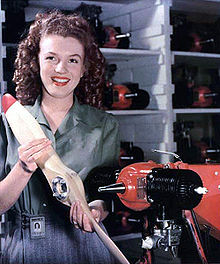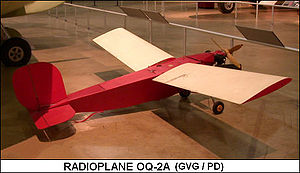- Radioplane OQ-2
-
OQ-1, OQ-2, OQ-3, OQ-7, OQ-13, and OQ-14 Role Target drone National origin United States Manufacturer Radioplane First flight 1939 Primary user USAAF Number built ca. 15,000 The OQ-2 Radioplane was the first mass-produced UAV or drone in the United States.
Development
Reginald Denny
The first large-scale production, purpose-built drone was the product of Reginald Denny. He served with the British Royal Flying Corps during World War I, and after the war emigrated to the United States to seek his fortunes in Hollywood as an actor. Denny had made a name for himself as an actor, and between acting jobs, he pursued his interest in radio control model aircraft in the 1930s. He and his business partners formed "Reginald Denny Industries" and opened a model plane shop in 1934 on Hollywood Boulevard known as "Reginald Denny Hobby Shops".[1]
Early Radioplane development
The shop evolved into the "Radioplane Company". Denny believed that low-cost RC aircraft would be very useful for training anti-aircraft gunners, and in 1935 he demonstrated a prototype target drone, the RP-1, to the US Army. Denny then bought a design from Walter Righter in 1938 and began marketing it to hobbyists as the Dennymite, and demonstrated it to the Army as the RP-2, and after modifications as the RP-3 and RP-4 in 1939.
Army purchase
 Marilyn Monroe with RP-5's prop
Marilyn Monroe with RP-5's prop
In 1940, the Army placed an order for 53 RP-4s, designating them the OQ-1, the "OQ" meaning a "subscale target". This small order led to a much bigger 1941 order from the US Army for the company's similar RP-5, which became the US Army OQ-2. The US Navy also bought the drone, designating it TDD-1 or "Target Drone Denny 1". Thousands were built, manufactured in a plant at the Van Nuys Airport in the Los Angeles metropolitan area. It was at this factory that in 1944 Army photographer David Conover saw a young lady named Norma Jeane, and thought she had potential as a model. This "discovery" led to fame for Jeane, who soon changed her name to Marilyn Monroe.
Description and variants
The OQ-2 was a simple aircraft, powered by a two-cylinder two-cycle piston engine, providing 6 horsepower (4.5 kW) and driving two contra-rotating propellers. The RC control system was built by Bendix. Launch was from a conventional runway, and recovery was either by returning to the runway or by parachute.
The OQ-2 led to a series of similar but improved variants, with the OQ-3 / TDD-2 and OQ-14 / TDD-3 produced in quantity. A number of other target drones were built by Radioplane and competing companies during the war, most of which never got beyond prototype stage, which accounts for the gaps in the designation sequence between "OQ-3" and "OQ-14".
During the war Radioplane manufactured nearly fifteen thousand drones. The company was bought by Northrop in 1952.
Specifications (OQ-2)
General characteristics
- Crew: None
- Length: 8 ft 8 in (2.65 m)
- Wingspan: 12 ft 3 in (3.73 m)
- Gross weight: 104 lb (47 kg)
- Powerplant: 1 × Righter O-15-1, 7 hp (5 kW)
Performance
- Maximum speed: 85 mph (137 km/h)
- Endurance: 1 hours 0 min
See also
- History of unmanned aerial vehicles#Reginald Denny and the Radioplane
- List of military aircraft of the United States
References
This article contains material that originally came from the web article Unmanned Aerial Vehicles by Greg Goebel, which exists in the Public Domain.
USAAF drone aircraft Controllable bombs Target control aircraft Aerial target (subscale) OQ-1 • OQ-2 • OQ-3 • OQ-4 • OQ-5 • OQ-6 • OQ-7 • OQ-11 • OQ-12 • OQ-13 • OQ-14 • OQ-15 • OQ-16 • OQ-17 • OQ-18 • OQ-19
Aerial target (full-scale) USN target drone aircraft pre-1945 Culver Radioplane TDD • TD4D
Douglas TD2D
Frankfort TD3D
Bell Naval Aircraft Factory Interstate TDR • TD2R • TD3R
Lists relating to aviation General Aircraft (manufacturers) · Aircraft engines (manufacturers) · Airlines (defunct) · Airports · Civil authorities · Museums · Registration prefixes · Rotorcraft (manufacturers) · TimelineMilitary Accidents/incidents Records Categories:- United States special-purpose aircraft 1940–1949
- UAVs and drones of the United States
Wikimedia Foundation. 2010.

